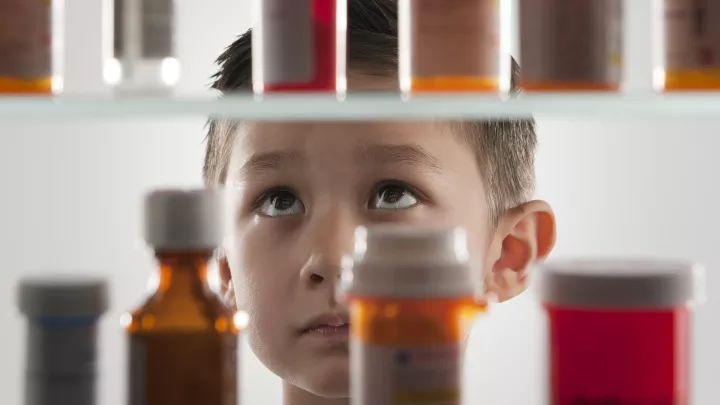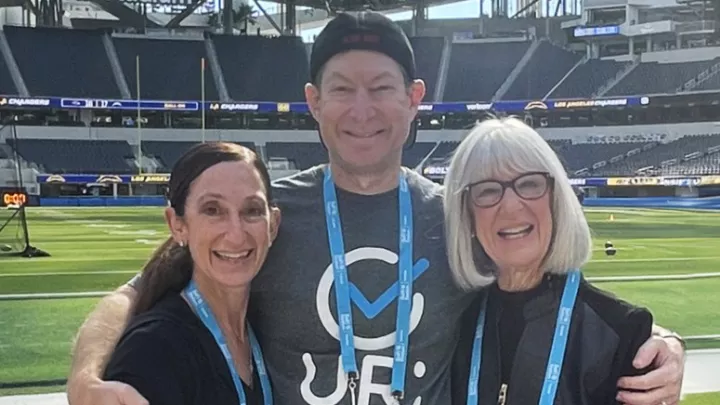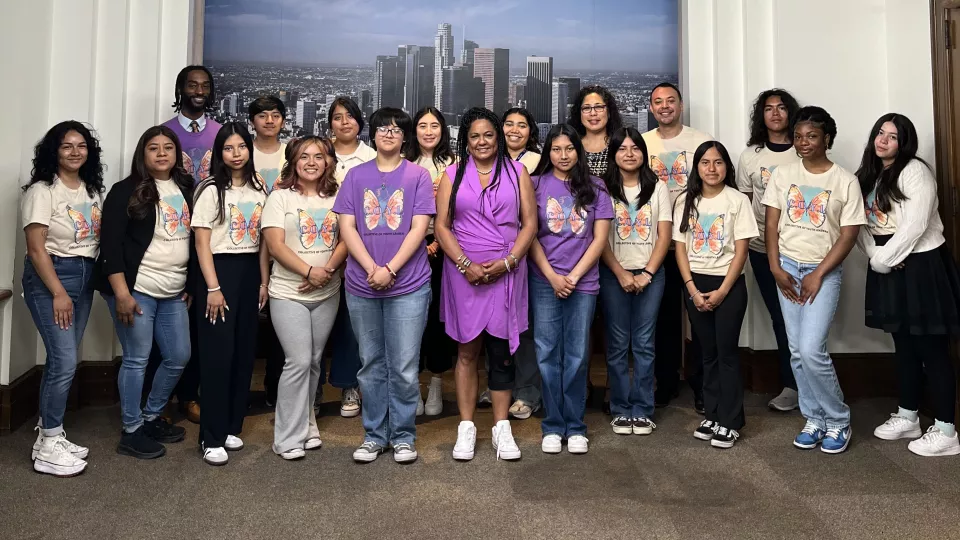
Program Manager Irene Lim, Program Administrator Jesus Escobar and Health Educators Melissa Diaz Raygosa, Jessica Rivera and Akayla Embry pose with members of the Collective of Youth Leaders, as well as L.A. Council District 10 Councilwoman Heather Hutt and Deputy for Planning and Economic Development Hakeem Parke-Davis.
Youth Activism: In CHLA’s Collective of Youth Leaders, BIPOC Teens Take Action to Prevent Opioid Overdoses
“I think oftentimes people have this perception about young people that they’re apathetic to things happening in the world around them,” says Jesus Escobar, a Program Administrator in the Division of Adolescent and Young Adult Medicine (DAYAM) at Children’s Hospital Los Angeles. “In my experience, that’s not the case at all.”
Escobar has been working with adolescents and young adults for over 15 years, and he sees the importance of bringing young people from different areas together. “Youth coming together from different parts of the city and really building connections with each other—that’s heartwarming to see,” he says. “They’re very passionate about impacting change in their communities.”
Along with Irene Lim, a Senior Program Manager in the Division of Adolescent and Young Adult Medicine, Escobar leads the Collective of Youth Leaders (COYL) at CHLA. This group consists of high school-age youth from various Los Angeles schools who are Black, Indigenous and People of Color (BIPOC). They regularly meet to discuss and address pressing issues in their communities. Such issues include social determinants of health, structural racism, and the harm that the war on drugs has had on low-income communities and Black, Indigenous, and other young people of color. Substance use prevention, and specifically the prevention of opioid overdoses, has become a major priority of the collective.
Transformation begins with listening
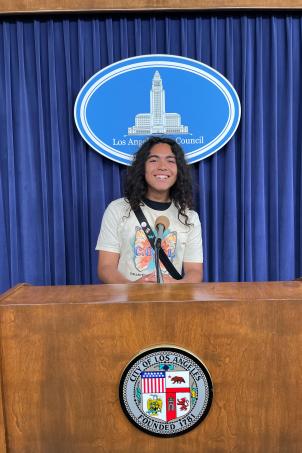
The Collective of Youth Leaders was initially born out of a May 2023 listening session, during which Escobar welcomed input from youth about issues they were interested in addressing on a local level. One of the individuals who took part in this session was Skye, now a rising junior at Alliance Dr. Olga Mohan High School. Skye, whose pronouns are he/them, was referred to the listening session by their school’s Youth Leadership Academy, which they took part in. “I really loved how the collective was advocating for change on certain issues and spreading awareness about the issues,” Skye explains. They have been a part of the group ever since.
As Escobar and team started meeting regularly, seven or eight individuals would consistently attend, bringing up issues that they were witnessing at school, at home and elsewhere in their communities.
By the summer of 2023, with the support of state funding for which Lim and her team in the Division of Adolescent and Young Adult Medicine had applied, the Collective of Youth Leaders was officially established. “The grant proposal we submitted was intended to build a youth leadership group, and we came up with the Collective of Youth Leaders name to communicate the reach we wanted the group to have,” Lim explains. “The students in the collective are leaders not just at their schools, but in their communities.”
Escobar assembled a staff to run the group. “We intentionally hired near peer-aged staff, so we have a very young team to help build a connection with the youth,” he explains. This team includes Health Education Associates Jessica Rivera, Melissa Diaz Raygosa and Akayla Embry. “Growing up in South Central Los Angeles, I was drawn to this role because it offers a unique opportunity to give back to my community by creating safer spaces where young people can thrive,” Rivera explains.
Raygosa, who also grew up in South Central L.A., knows firsthand the impact that a group like the Collective of Youth Leaders can have. “I was previously in a youth leadership group called Wellness and Substance Use Prevention back in 2017, which focused on uplifting communities through social change, advocacy and amplifying youth voices,” she says. She knew she wanted to continue this type of work as she grew older, which is what brought her to her current role.
Embry describes some of the ways in which the health education associates support the group. “We deliver presentations on topics that support their structural change goals and help them to create materials for tabling and outreach,” she explains. “More than that, we work to make sure our youth feel safe and welcomed in the space we have created for them.”
With the team established, by the fall of 2024, the collective had grown to over 20 young people from a half dozen different high schools meeting on a biweekly basis through a mix of in-person and virtual gatherings.
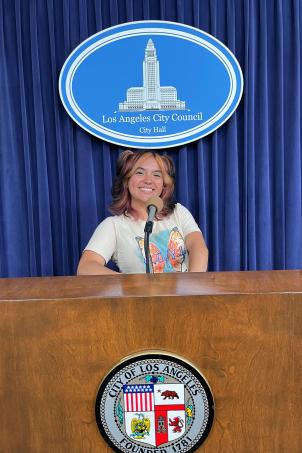
Amy, a senior who also attends Alliance Dr. Olga Mohan High School, was one of the students recruited to the Collective of Youth Leaders later in its development. “I learned about COYL from a tabling event they had at my school,” she says. “Their fliers mentioned advocating for our community and learning about the impact of substance abuse and its connection to mental health and other issues. That made me really interested in learning more because I feel that these issues aren’t normally discussed with youth communities.”
Most members live in South and Central Los Angeles. Opioid overdoses occur frequently in these areas, and a common theme among input from members was the desire to educate themselves and others on strategies to prevent such overdoses. “Some of the youth in the group expressed that they have friends or family members who have unfortunately been affected by opioid overdose,” Escobar says. “This really prompted them to want to enact change around this issue.”
Training to save lives while advocating to change them
Enacting change began with the collective establishing collaborations with several community-based organizations, including one called End Overdose. Escobar started bringing in individuals from this organization to train collective youth in how to identify and respond to the signs of an opioid overdose. This response involves using naloxone, a medicine that quickly reverses an opioid overdose. Naloxone, which can be administered to a person through a NARCAN nasal spray device, attaches to an individual’s opioid receptors and blocks the effects of opioids entering the body.
At the end of each training session, participating members would receive a certification in the use of a NARCAN kit, enabling them to take action if they witnessed someone experiencing an overdose. But they weren’t satisfied with stopping there. They wanted to figure out how to expand access to naloxone in their communities and enable themselves and their peers to carry NARCAN kits with them at school.
The collective’s next step was to connect with the Los Angeles City Council. “We began working with Council District 10,” Escobar explains. He communicated with the district’s Deputy for Planning and Economic Development, Hakeem Parke-Davis, who helped to build a connection between the Collective of Youth Leaders and Councilwoman Heather Hutt’s office. “Their staff led civic engagement workshops for the COYL youth where they talked about what goes into identifying an issue and creating or modifying a policy,” Escobar says.
The collective went on to host a meeting with Council District 10, during which the youth offered specific ideas on how to increase naloxone access in their communities. Due in part to the efforts of the COYL, Council District 10 is now planning to increase their supply of naloxone and is exploring how to make it more easily available. Members also worked to design and distribute a youth-friendly pamphlet with opioid overdose prevention information.
Members also turned their attention to their schools. Several youth in the collective, including both Skye and Amy, attend one of the Alliance College-Ready Public Schools in Los Angeles, part of a nonprofit public charter school network. They are now working with this school district to try to change a policy so that youth may more easily carry NARCAN while at school. “It would be a huge policy change in schools where young people could carry NARCAN without any punitive measures or assumptions that they themselves are opioid users,” Lim says. “It’s about saving lives if they see someone who needs help.”
City Hall surprises
As the Collective of Youth Leaders carried this work forward and Council District 10 took note of the group’s efforts, Escobar and team worked with Parke-Davis to plan a special surprise for the members: a trip to City Hall and participation in the June 28, 2024 City Council Meeting. “It was a full-on field trip,” Lim says. “They rolled out the red carpet for this group.”
While there, the students were guided around the building by Parke-Davis and had the chance to speak with him and others about the experience of working in local politics. They were also invited into the City Council meeting that day and were able to make public comment.
“My comment was about naloxone, addressing how opioid overdoses are a threat to the public,” Skye says. “It was an amazing advocacy opportunity.”
Amy agrees. “They were really respectful of us and were encouraging us to advocate and speak up about problems in our communities.”
The biggest surprise of all came late in the meeting, when Councilwoman Hutt publicly acknowledged and thanked the Collective of Youth Leaders for their accomplishments.
Escobar and Lim were thrilled to see the City Hall trip come to fruition. “The youth witnessed local city government in action,” Lim says. “Many of them made comments about how they could see themselves doing this when they grow up.” In fact, since the trip, several of the youth have submitted applications to join the L.A. City Youth Council.
Inspiring change and building bonds
As collective members look ahead, they hope to achieve even more for their communities. “I would love to see our program get into more widespread NARCAN training,” Amy says. They are now organizing a training session that will enable members themselves to train their peers and community members in how to use NARCAN.
“I also hope for COYL to partner with LA Metro to help distribute our pamphlets,” Skye says.
Escobar recognizes just how impactful these youth are. “When you think about young people, they are our future,” he says. “And providing the space and conditions in which they can thrive and grow—that's our responsibility.”
Update, Dec. 20, 2024: The Collective of Youth Leaders was informed that the Alliance School Board unanimously voted to pass and approve the Student Naloxone Policy amendment written by COYL participants. As a result, students in the Alliance School District are now able to carry NARCAN while on campus and during school events without disciplinary action. Following this success, COYL participants are intensifying their efforts to help lead NARCAN training sessions for their peers moving forward.

